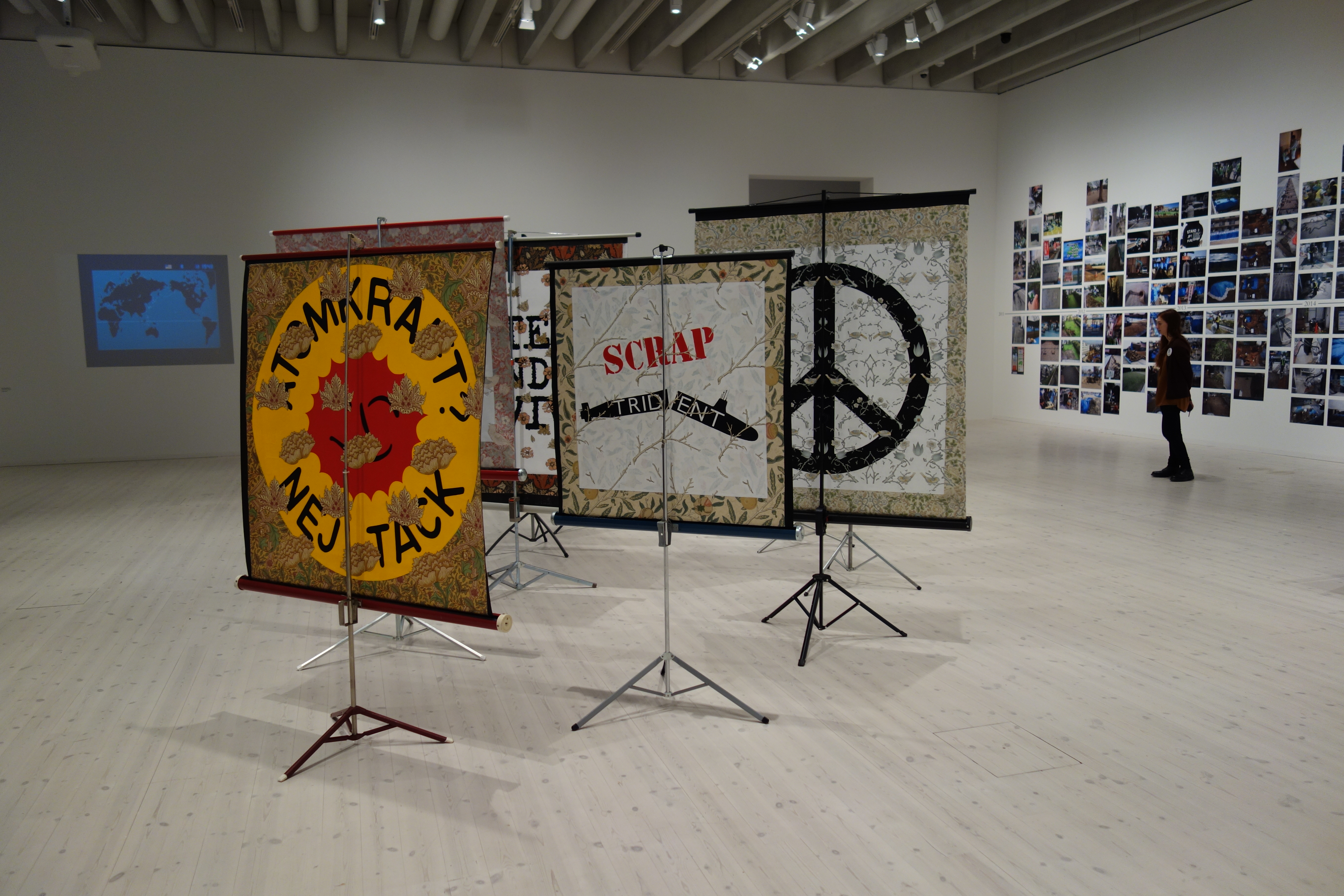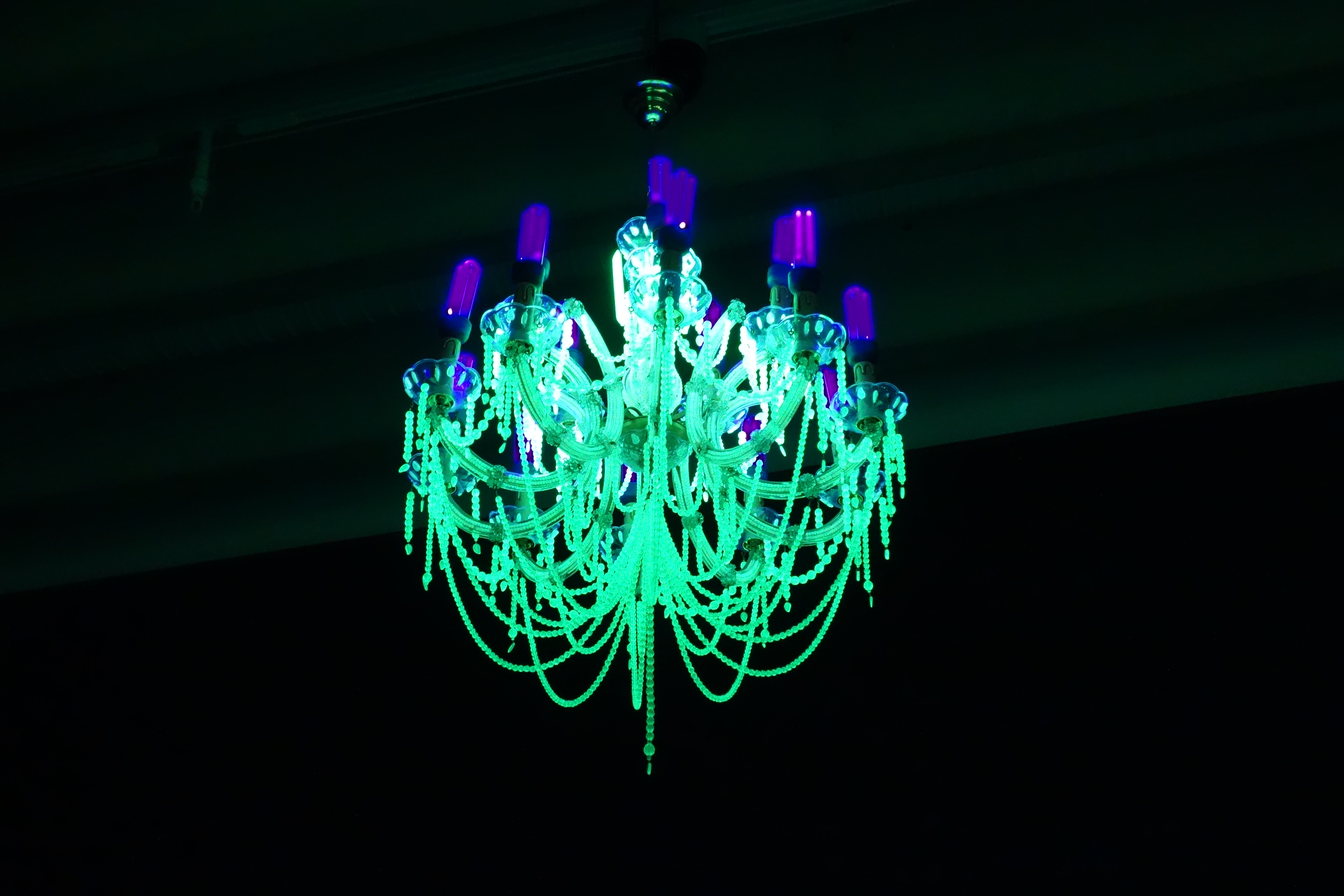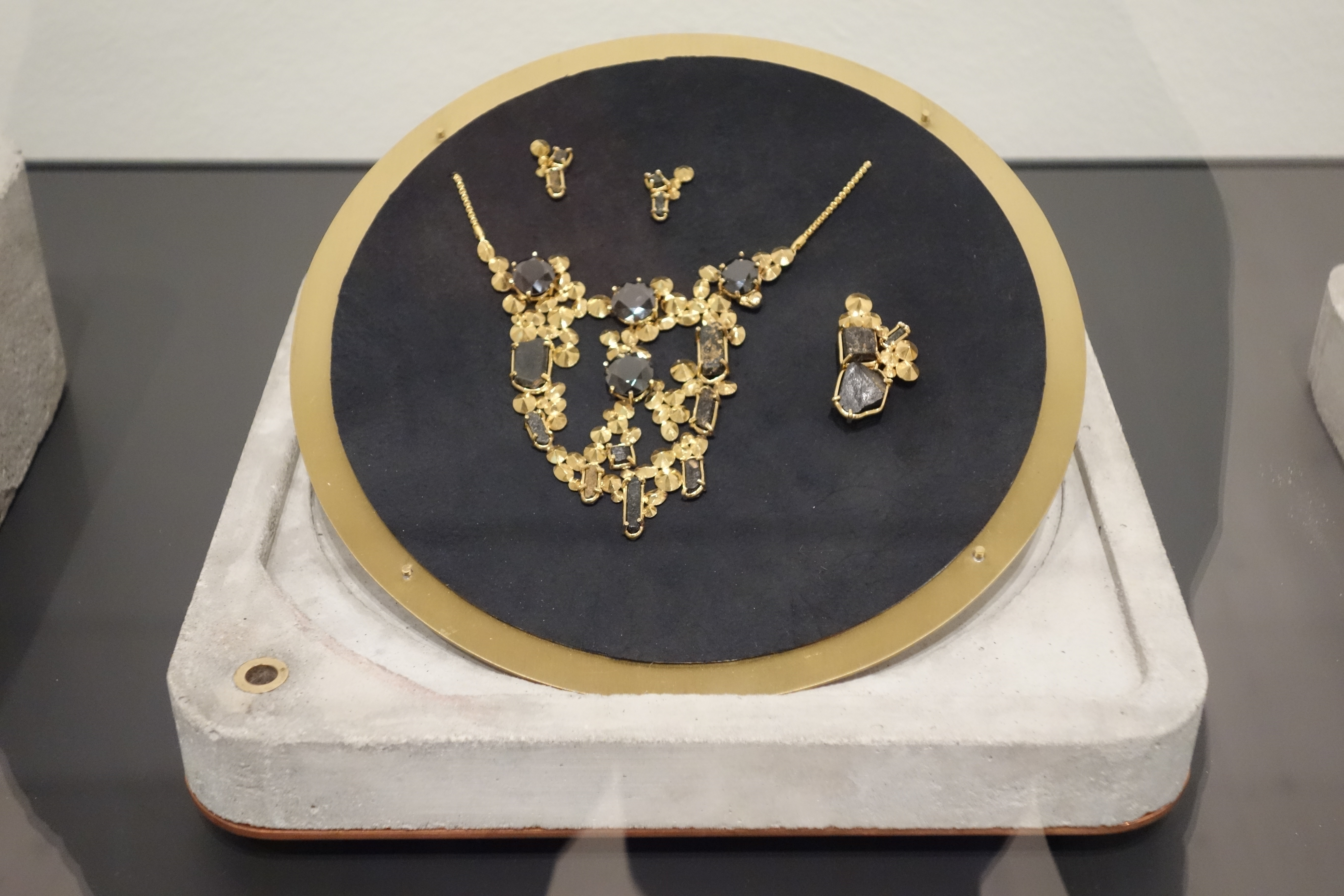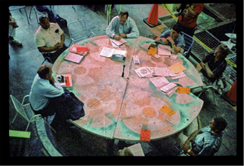Why We Need Nuclear Art
Green glowing chandeliers, jewellery you’ll never be able to wear … A review of the exhibition “Perpetual Uncertainty / Contemporary Art in the Nuclear Anthropocene” at the Bildmuseet, Umeå.

The uppermost floor of the exhibition Perpetual Uncertainty in the Bildmuseet, Umeå. Photo: A. Volkmar.
In public discourse the nuclear usually oscillates between the uncanny and the sublime, that is, the shockingly close (e.g. radioactive particles inside my body) and the mightily distant (e.g. a nuclear explosion). To designate the middle ground, the “space of care” as the curator of the show Ele Carpenter puts it, and perhaps find a language to speak about the title-giving perpetual uncertainty that governs this space, is the objective that was set for this exhibition. If we want to better understand the nuclear condition that we are all part of, we also need to address political, social, aesthetic questions, because science doesn't have all the answers either. “Uranium has a half-life of 4.5 billion years,” Carpenter explains in the introductory video, “what does that mean? Artists are no scientists but they can look at scientific knowledge more holistically.”
The uncertain middle ground
Perpetual Uncertainty brings together thirty artists from Europe, Japan, the USA and Australia with many of whom Carpenter entertains a long term cooperation that includes exhibitions, roundtables and even field trips to Fukushima and Belgium's underground Nuclear Waste Depository Lab HADES. The exhibition extends over four floors of the Bildmuseet, the art museum of Umeå University in Sweden. Despite the solemn atmosphere that is evoked by the museum’s white cube interior design, the works on display are anything but removed contemporary issues. They cover a range of nuclear concerns: from the very specific challenges of dismantling a nuclear submarine to the murky question when Chernobyl will be ‘safe’ again. And some works are really a pleasure to look at.

Julia and Ken Yonetani, “Crystal Palace: The Great Exhibition of the Works of Industry of all Nuclear Nations” (2013), detail. Photo: A. Volkmar.
On the third exhibition floor, I enter a pitch-black room. As I walk around a corner an eerie green light welcomes me, the source of which I discover to be fourteen chandeliers hanging from the ceiling. As the explanation reads, they represent part of the thirty-one “nuclear nations” in the world, i.e. nations that operate nuclear power plants. The artists, Ken and Julia Yonetani, took antique chandelier frames and equipped them with uranium glass, which glows green in UV light. The size of each chandelier corresponds to the amount of nuclear power produced in the country it represents. Referring in its title to “The Great Exhibition of the Works of Industry of All Nations” that was held in London in 1851, this work also comments on our fetish with reactors and bombs. It is telling, after all, that only nations with nuclear power and nuclear weapons are acknowledged to pursue ‘nuclear activities’ while the countries supplying them with fuel fall off the radar. Using uranium glass, Julia Yonetani explains in an interview, “we connect the [fuel] material back to the consumer.” Personally, the eerie glow of the uranium glass makes me wonder about the amount of radioactivity I receive in this room, notwithstanding the fact that uranium glass was a fashionable tableware in the early twentieth century.

Erich Berger and Mari Keto, “Inheritance” (2016), detail. Photo: A. Volkmar.
Another remarkable piece in the show is Erich Berger and Mari Keto’s “Inheritance” (2016). It consists of a stack of concrete and metal containers that shelter a set of jewellery artefacts made of gold and other precious metals but also of naturally mined Thorianite and Uraninite, along with an archaic looking set of instruments and a copper plate with instructions screwed on top of them. The idea is to perform a low-tech ritual with the provided instruments to test if the jewellery is safe to wear, which must be repeated by every generation until the jewellery is not radioactive anymore. The catch is of course, that with half-lives exceeding several million years, this piece of jewellery will never be safe to wear for any human to come. Berger and Keto thus encapsulate the abstract idea of deep time into a ritual act that needs no special gadgets or scientific protocols to be performed.
James Acord’s Roundtable
The exhibition aims to open a space for debate, inspired by James Acord’s Roundtable built in the artist’s studio to bring together nuclear engineers and environmentalists to discuss the clean-up of the Hanford Site, home of the atomic bomb, in 1999. A replica has been installed on one of the exhibition floors. James Acord (1944-2011) was an American sculptor and the only private individual in the world licensed to own and handle radioactive materials. He didn’t necessarily present the Roundtable as part of his artistic practice, as Carpenter remarks in the exhibition catalogue. Nevertheless, she further explains, it inspired the nuclear culture project, of which the exhibition is part, to the extent that art becomes the host (not necessarily a neutral one) of a dialogue in which diverse experiences and positions can be shared.

James Acord’s original Roundtable, Hanford, 1999
No art for lazy people
Considering that contemporary art often remains enigmatic to the lay public – and the works that are shown in this exhibition are no exception – this is an ambitious aim. As compelling as many works are, the visitor is not presented with a statement or solution, even their informative value is often questionable. However, there are many contact points to familiar situations and experiences that allow for an easier access to the complex issues that are touched upon in this exhibition. The visitor, in other words, is not only presented a work (of art) but put to work herself, which I consider the true strength of this show. Nonetheless, this means that as a visitor of this exhibition you must be willing to invest some effort, otherwise it’s not going to work for you.
Moreover, the exhibition is accompanied by a diverse programme of talks, guided tours, screenings and roundtable discussions. During the time in which I was visiting the exhibition I participated in a series of lectures and roundtable discussions that brought together artists, researchers, and representatives from the nuclear industries and NGO’s. Although there was a noticeable lack of lay people and students from Umea University, the background of the participants was diverse enough to fuel open and critical discussions. It was in these discussions that I felt the spirit of James Acord’s Roundtable most vividly carried on.
The exhibition is curated by Ele Carpenter from Goldsmiths University and will be on display until 16 April 2017.
Further Reading:
Carpenter, Ele, ed. The Nuclear Culture Source Book. London: Black Dog Publishing, 2016. Print.
© Anna Volkmar and Leiden Arts in Society Blog, 2016. Unauthorised use and/or duplication of this material without express and written permission from this site’s author and/or owner is strictly prohibited. Excerpts and links may be used, provided that full and clear credit is given to Anna Volkmar and Leiden Arts in Society Blog with appropriate and specific direction to the original content.



0 Comments